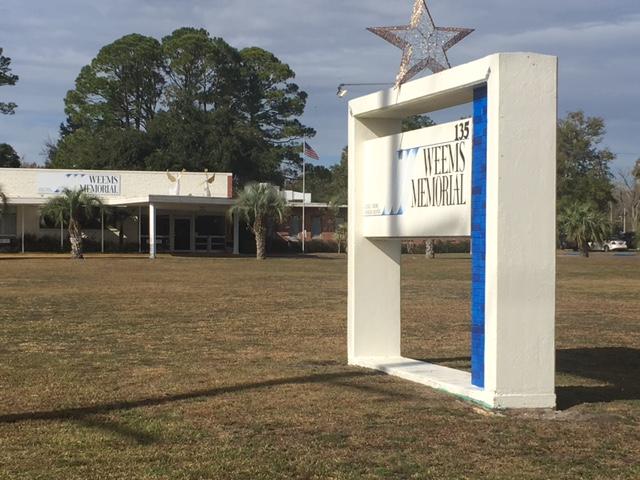‘Sustainability’ raised with Weems proposed expansion
The proposed expansion of Weems Memorial Hospital, now expected to cost anywhere from $16 million to $23 million, was center stage at last week’s county commission meeting.
Weems CEO David Walker, with representatives of Birmingham, Alabama-based healthcare architects TRO Jung | Brannen attending online, presented details of a pair of design options to the county commissioners at their Sept. 19 meeting. Commissioner Noah Lockley was absent due to a physician’s appointment, and commissioners included a prayer for his good health at the meeting’s start.
Walker said the option for a fully connected nearly 18,000 square foot addition, which is Weems’ existing plan, could be built at a cost of $650 to $750 per square foot.
The expansion, which would create an overall footprint of close to 25,000 square feet for Weems, would cost for construction anywhere from $16.05 million to $18.52 million – and would run another $2.37 million to $2.7 million in soft cost for equipment, furnishings – for a total price tag of between $19.71 million to $22.91 million.
The second option would be a 17,700-square foot freestanding emergency department, connected to the hospital by a partially enclosed canopy, and with a second public entrance on 10th street. “There would be minimal tie-in to the existing structure,” Walker said. “It’s only been developed on a conceptual level.
This second option would have six exam treatment rooms and two oversized treatment rooms for trauma. Walker said construction would run between $11.25 million to $12.98 million for construction – with soft costs of between $2.11 million to $2.4 million – for a total of between $14.25 million to $16.41 million.
Asked by Commissioner Jessica Ward what inflation numbers were used for the calculations, TRO’s Dick Richard said the numbers were fresh, with cost figures as of the last three weeks.
Ward said she liked the options, noting that six would be preferable to four emergency treatment rooms.
Walker outlined a number of policy changes on a state and federal level that could impact the decisions made going forward. One of them, REH (Rural Emergency Healthcare) is a new Medicare provider designation established by Congress in 2021, which is meant to reinforce access to outpatient medical services and reduce health disparities in areas that may not be able to sustain a full-service hospital.

The addition would have four emergency department exam treatment rooms, one oversized treatment room for trauma cases, one isolation room for treatment, an inpatient shell that could be used for 10 inpatient beds, a physical therapy room and areas for x-ray. CT scan, ultrasound and laboratory tests. Mammography would be an option.
Walker said the impact of abandoning inpatient care, in exchange for additional funds for emergency and outpatient care, will be examined in the months to come.
“What they’re trying to do is prevent these rural hospitals from closing,” Walker said. “You have to close inpatient beds, but get millions to offset it.”
Commissioners want to see long-term projections
Walker asked whether a sustainability study had been completed. “If we build this, can we sustain it, with what we currently have, going in and coming out?” she asked.
The county would have to do a financial feasibility study in order to secure loan monies from the U.S. Department of Agriculture, “to see technically whether you can afford a building like this,” Walker said, holding up the paper containing the outline of the hospital’s two design options.
“So you’re saying the USDA would never agree to give us money unless they think we can actually pay for it?” Jones said.
Commissioner Cheryl Sanders voiced skepticism, asking whether Weems had lined up specialists and what the numbers would look like down the road.
“Have you done anything that would be like an analysis of long-term projections of where this could be in five, 10 years?” she asked.
Walker said the project had been in the works since 2015. “The county is growing, we’re going to have more visits by people coming for tourism things like that,” he said. “There’s an already planned and interlocal agreement. We’re building something for a growing population in the county.”
He said that Michael Kosar, from Alliant, the hospital’s consultant, has talked to some gastroenterologists.
“When did he talk to them, David?” asked Sanders. “Maybe that’s a conversation we need to have with Mr. Kosar.”
She also asked about the results of a number crunch they have asked of the hospital’s auditor, regarding separating out the expense costs of running the ambulance service as a separate department and the clinics individually.
Butterfield named to hospital board
Speaking as a member of the public, Eastpoint’s Donna Butterfield, a longtime watchdog of Weems, said that the hospital’s claim that the plans have been approved by the Agency for Health Care Administration through the second stage are “not technically true.”
She said she spoke with the AHCA employee charged with overseeing Weems building plans, and who had worked on the original, and was told “the original Weems plans have been archived since so much time has elapsed.
“The Weems plans were based on building codes from 2019, and since the building code was revised in 2020, all those weems plans will need to be resubmitted with new codes applied to construction,” Butterfield said she was told. “He said (construction costs) for another rural hospital to be built in Blountstown have doubled from what was originally stated.
““I have no reason to believe he’s not telling me the truth,” she said. “I really don’t understand how a project of this financial magnitude can be based on misleading if not actually faulty information.”
Mason Bean, president of the Concerned Citizens of Franklin County, was brief and pointed.
“I am impressed with all your questions and challenges,” he said. “We all deserve a standalone emergency facility somewhere centrally located.”
He said a mortgage payment for a loan taken out with USDA would average about $70,000 a month.
Walker disputed Butterfield’s characterization regarding the potential for greater building and design costs, and said he had spoken with AHCA’s head of building, with Weems’s facility manager Craig Gibson also in attendance.
Jones stressed several times that the cost of expanding the hospital would be paid for entirely out of the one-cent sales tax voters approved several years ago.
“I understand some of these numbers I really don’t like,” he said. “This is budget neutral to the county, it’s not coming out of ad valorem.”
He said the commissioners in place at the time had put the matter before the people and they had decided.
“I know we can’t go back today and we can’t just throw off agreements we made with municipalities,” Jones said. “I do understand it’s going to be very expensive. We can start having better health care in Franklin County or we can continue to do what we’re doing. At some point we have to step up and make it better.”
Ward indicated she would like to see action taken soon.
“We need to do something,” she said. “Pee or get off the pot with it. We want to make sure if we do it it’s sustainable, that we can afford it in other words.”
Later in the meeting commissioners backed Jones’ decision to place Butterfield on the Weems hospital board, as the representative of his Eastpoint-St. George Island district.
The board also agreed to alter its plans to advertise for a Request for Qualifications for a healthcare consultant, since the contract with Alliant Health Solutions is set to expire.
County Coordinator Michael Morón said the RFQ should make sure a health care consultant would explain the pros and cons of the Critical Access Hospital and Rural Emergency Hospitals designations, assist the county with workshops on a path forward for Weems, created a commissioner-approved RFQ based on the agreed-to direction of Weems, and assist the county with interviews and selection of the candidates.
“They would not have any conflicts with any potential candidates that may show
interest in managing or leasing Weems,” Morón noted in his report.
“This (arms-length) will be based on what we see in front of us,” said Sanders.
“Nobody here (on the board) knows anything about the business side of healthcare,” said Commissioner Ottice Amison. “I’m adamant about getting the county out of health care. Politics has no place in medicine.”
Jones noted that the terms being presented in the RFQ would enable a consultant familiar in mergers and acquisitions to provide advice.




Meet the Editor
David Adlerstein, The Apalachicola Times’ digital editor, started with the news outlet in January 2002 as a reporter.
Prior to then, David Adlerstein began as a newspaperman with a small Boston weekly, after graduating magna cum laude from Brandeis University in Waltham, Massachusetts. He later edited the weekly Bellville Times, and as business reporter for the daily Marion Star, both not far from his hometown of Columbus, Ohio.
In 1995, he moved to South Florida, and worked as a business reporter and editor of Medical Business newspaper. In Jan. 2002, he began with the Apalachicola Times, first as reporter and later as editor, and in Oct. 2020, also began editing the Port St. Joe Star.